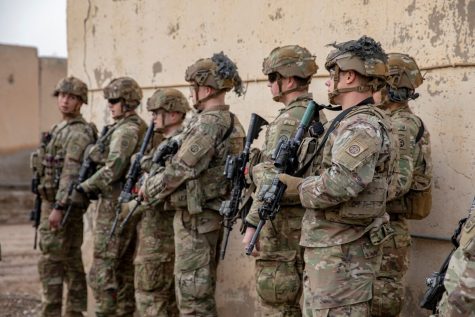The Final withdrawal of US Soldiers in Iraq and Afghanistan
March 4, 2021

You were dropped in a foreign land. You don’t speak the language. You have no idea where to go. No food, no shelter, nothing. All you were told was you need to keep these people safe, but guess what? You don’t have what you need. You’re expected to protect these people who don’t want you there. What are you supposed to do when people are setting bombs to blow you up but you’re trying to save their lives? That is the situation all the U.S. Marines are in right now as they are placed into Afghanistan. There are soldiers being sent to foreign countries to risk their life but they know little of what they are fighting for. These brave and selfless heroes are being killed by the people they are trying to protect. This is the situation the US forces have been in for the past 20 years in Iraq and Afghanistan.
U.S. forces have been in Afghanistan since 2001 when they invaded in response to the 9/11 attacks planned by al-Qaeda, the militant group that enjoyed refuge while the Taliban ruled Afghanistan. The U.S.-led invasion quickly toppled the Taliban from power, but the ensuing conflict dragged on far longer than expected. U.S. troops invaded Iraq in 2003 and left in 2011 but returned in 2014 after the Islamic State group overran large parts of Iraq. The soldiers in Iraq arrived directly after 9/11 to try and fight the Taliban as well as many terrorist groups, hoping to get rid of them or create peace. On Jan. 15 2021, the final withdrawal of the soldiers was made leaving only 2,500 service members in Iraq. The lowest number since the operations there started. The number of U.S. troops in Afghanistan has also reached 2,500. At its high point in 2011, there were 98,000 U.S. troops in the country. These withdrawal reductions were longtime goals of the Trump administration.The move was immediately opposed by the opposition Democratic Party of the President-elect Joe Biden, whose lawmakers described it as a threat to national security. Several Republican lawmakers also opposed the move because they believe it would increase ISIS’ power and would be a threat to the rest of the world.
The drawdown of U.S. forces in Iraq is a direct outcome of the successful Iraqi military campaign against ISIS.
Defense Secretary Chris Miller said in a written interview conducted by the Defense Gov. “The drawdown of U.S. force levels in Iraq is reflective of the increased capabilities of the Iraqi security forces We have long anticipated that the force level required to support Iraq’s fight against ISIS would decrease as Iraq’s capability to manage the threat from ISIS improves. Our ability to reduce force levels is evidence of real progress.”
The acting secretary stressed the reduction of American force strength does not mean a change in U.S. policy in the country or region. U.S. forces will continue to work with Iraqi security forces and forces from the anti-ISIS coalition to ensure the enduring defeat of the terrorist group.
“Iraqi government officials know that ISIS remains a threat, and the presence of U.S. and coalition forces helps build Iraqi forces and deters the reconstitution of the terror network in the country”, Miller said.”We will continue to have a counterterrorism platform in Iraq to support partner forces with air power and intelligence. Most operations in Iraq were already being conducted by our Iraqi partners, enabled by U.S. and Coalition forces. We can continue to provide this support to our Iraqi partners at the reduced U.S. force level.”
“Today, the United States is closer than ever to ending nearly two decades of war and welcoming in an Afghan-owned, Afghan-led peace process to achieve a political settlement and a permanent and comprehensive cease-fire,” Miller said. “In August last year, there were 8,000 U.S. troops in Afghanistan, according to NATO‘s Resolute Support Mission. the force of 2,500 will give commanders what they need to keep America, our people and our interests safe.”
The force reduction shows U.S. support for the Afghan peace process that was negotiated with the Taliban.
“Moving forward, while the department continues with planning capable of further reducing U.S. troop levels to zero by May of 2021, any such future drawdowns remain conditions-based,” Miller wrote. “All sides must demonstrate their commitment to advancing the peace process. Further, the United States will continue to take any action necessary to ensure protection of our homeland, our citizens and our interests.”